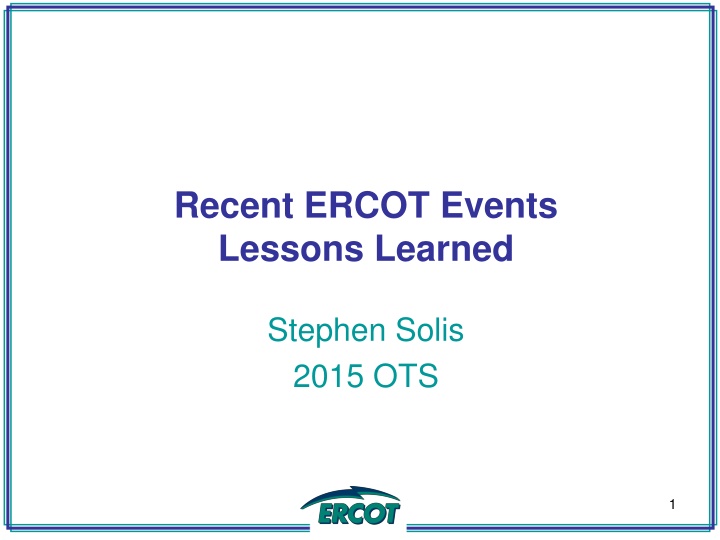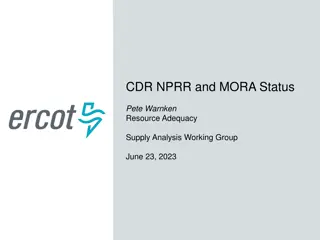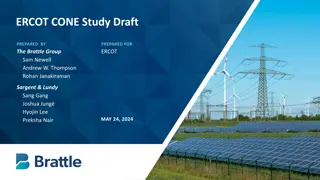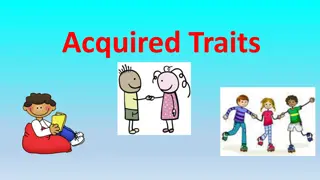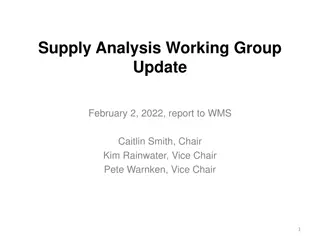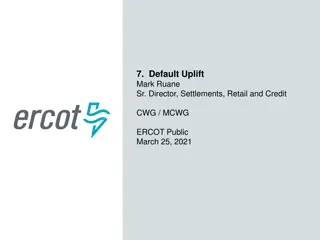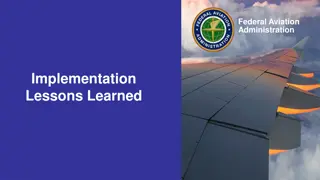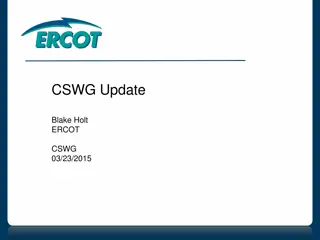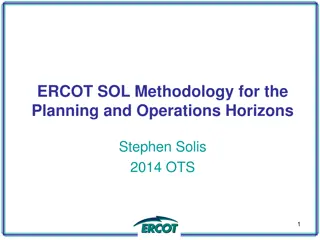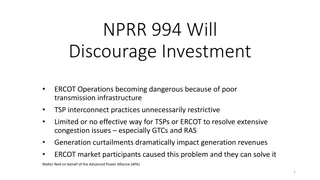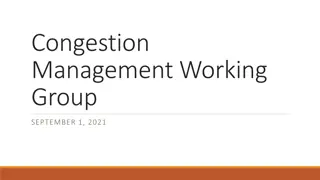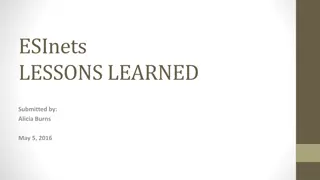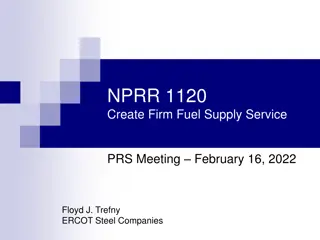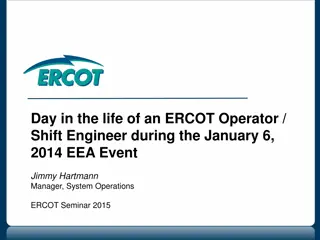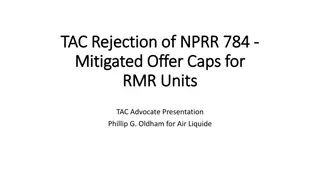Lessons Learned from Recent ERCOT Events in 2014
Explore the beneficial actions taken by Transmission Operators during Energy Emergency Alerts in ERCOT, specifically during the events on January 6, 2014. Review the timeline of events, generation outages, and cold weather-related outages impacting energy availability. Gain insights into communication protocols and operational responses to ensure grid stability and reliability.
Download Presentation

Please find below an Image/Link to download the presentation.
The content on the website is provided AS IS for your information and personal use only. It may not be sold, licensed, or shared on other websites without obtaining consent from the author.If you encounter any issues during the download, it is possible that the publisher has removed the file from their server.
You are allowed to download the files provided on this website for personal or commercial use, subject to the condition that they are used lawfully. All files are the property of their respective owners.
The content on the website is provided AS IS for your information and personal use only. It may not be sold, licensed, or shared on other websites without obtaining consent from the author.
E N D
Presentation Transcript
Recent ERCOT Events Lessons Learned Stephen Solis 2015 OTS 1
Objectives At the completion of this course of instruction you will: Identify the beneficial actions that a Transmission Operator (TO) takes during an EEA (1/06/14 event). Identify the beneficial actions that a TO takes during a localized Transmission Emergency (10/08/14 event). Identify the communication protocol to be utilized during these situations. 2
January 6, 2014 EEA event At 6:52, ERCOT declared Level 1 of its Energy Emergency Alert (EEA) and declared EEA Level 2 at 7:01, primarily due to the loss of a number of generating units Non-Spin Reserve Service (NSRS), Load Resources (LR) and Emergency Response Service (ERS) were deployed, but firm load shed was not required ERCOT moved from EEA2 to EEA1 at 7:51 and resumed normal operations at 9:12 Generation outages & derates peaked at 9355 MW just before 07:00, with 3541 MW due to weather Hourly peak demand was 55,487 MW for HE08 and instantaneous peak demand was 56,478 MW at 07:08:24 3
Timeline January 6, 2014 EEA EEA Level 1 cancelled. Watch remains in effect. 07:51 AM ERCOT recalled EEA Level 2. EEA Level 1 remains in effect 07:56 AM ERCOT recalled 30 minute ERS 07:58 AM ERCOT recalled 10 minute ERS. ERCOT issued EEA Level 1 for PRC below 2300 MW ERCOT issued EEA Level 2 for PRC below 1750 MW Watch terminated as PRC was above 3000 MW Watch issued due to PRC below 2500 MW 06:42 AM 07:01 AM 09:12 AM 09:55 AM 06:52 AM 06:42 AM 06:57 AM 06:52 AM 06:37 AM 07:02 AM ERCOT deployed 30 minute ERS for 111.68 MW 07:05 AM ERCOT deployed 10 minute ERS for 508.72 MW 07:13 AM ERCOT recalled all RRS from Generators due to frequency above 59.91 Hz 08:10 :36 AM ERCOT recalled all Non- Spin 08:10:48 AM ERCOT deployed RRS to Generators for frequency below 59.91 Hz 08:17 AM ERCOT recalled all RRS from Generators due to frequency above 59.91 Hz ERCOT deployed Non-Spin for 187 MW ERCOT deployed Group 1 RRS for 546.36 MW 07:43 AM ERCOT recalled all Group 2 RRS 07:50 AM ERCOT recalled all Group 1 RRS ERCOT deployed RRS to Generators for frequency below 59.91 Hz ERCOT deployed Group 2 RRS for 536.24 MW 4
Generation Outages Note: This does not include outages which occurred before midnight on January 6 EEA1 Active EEA2 Active 5
Cold Weather Related Outages 2/2/11 - Approximately 2/3 of unavailable MW was related to cold weather. 1/6/14 - Approximately 1/3 of unavailable MW was related to cold weather. 6
How cold was it? 25 20 Feb 2, 2011 Wind Speed 15 10 Jan 6, 2014 Wind Speed 5 0 Dallas Houston Austin San Antonio Brownsville Midland 50 40 Feb 2, 2011 Temp 30 20 Jan 6, 2014 Temp 10 0 Dallas Houston Austin San Antonio Brownsville Midland 7
Frequency Disturbances Large unit trip 6:30 to 7:00 loss of generation plus load ramp 8
Lessons Learned ERCOT should continue its winterization site visits ERCOT should continue to give advanced notice to market participants when cold weather approaches ERCOT should review the use of PRC as currently defined as the trigger for reserve monitoring and declaration of emergency operations. No 3 part communications issues were observed 9
TO beneficial actions in advance of cold weather Restoring any available transmission outages Especially beneficial if icing anticipated May allow additional generation output Reviewing emergency procedures Reviewing communication protocols Clear and concise communications 3 part communications 10
TO beneficial actions during an EEA General Communicating to TSPs that a TO represents 3 part communications Reactive Support EEA1 Coordinating DC Tie schedules Deploying Load Management programs EEA2 Distribution Voltage Reduction Media Appeals for conservation EEA3 Firm load shed 11
Timeline October 8, 2014 Transmission Emergency The DLONOR58_S104A constraint was released as it began to back down Valley wind Sharyland TSP reported that CFE can increase the 50 MW of emergency energy being supplied from CFE to 90 MW. ERCOT accepted. Emergency Energy from CFE ended ERCOT ended the Transmission Emergency in the Rio Grande Valley. ERCOT posted the Transmission Emergency to the Market Information System (MIS). ERCOT issues instructiosn to AEP, BPUB and STEC to restore their share of 100 MW of load ERCOT activated the Rio Grande Valley GTC. TSP 1 Sheds 680 MW of load 18:01 19:18 15:56-57 16:07 16:12 17:05 17:58 19:15 15:50 16:00 16:47-49 18:09 18:29 The SLA_RIO8_ RIOHND_ERIOHND constraint was released so that local wind generation would not be curtailed. LOAD RESTORATION First amount of load restored NEDIN G3 steamer unit tripped 243 MW. Followed by G1 & G2, an additional 408 MW AEP, BPUB and STEC were instructed to shed their share of 200 MW of load Final amount of load restored. 12
Overview To Lon Hill Ajo North Endinburg Duke Riohondo Railroad MV Burns La Palma 16
Load Shed 17
LoadForecast 19
Lessons Learned Review all combined-cycle contingency definitions Create load shed displays based off individual TO load Develop tool to more easily simulate UVLS actions for steady state analysis. Utilize this event as an emergency operations training scenario. Specifically review methods to implement more target load shed when necessary. Add checkboxes to Constraint Management Plans 20
TO beneficial actions during a local Transmission Emergency Restoring Outages Coordinating Constraint Management Plans Re-rating transmission facilities during Emergency Verifying any automatic relay setpoints Communicating to TSPs that a TO represents 3 part communications 21
TO beneficial actions during a local Transmission Emergency (cont) Reactive Support Coordinating DC Tie schedules(if applicable) Deploying Load Management programs(if applicable) Distribution Voltage Reduction Media Appeals for conservation Firm load shed 22
3 Part Communications New Standard COM-002-4 coming by 2016 Directives must be communicated in a clear, concise, and definitive manner. 3 Part Communication involves both the issuer and the receiver of a directive to be successful. ERCOT and ERCOT TOs issue directives 23
3 Part Communications during an Emergency 3 Part Communications even more critical Miscommunications can result in more severe consequences Compliance sanctions more severe Reinforce before or during an Emergency Clarify Facility names if necessary Be patient and mute phones during Hotline Work together and call back if needed 24
Summary Two different types of emergencies with similar TO beneficial actions. 3 part communications critical during emergencies Efforts to prepare for cold weather yields positive results Event Analysis yields positive observations and Lessons Learned 25
Questions 26
Questions 1. Which of the following actions may be taken by the Transmission Operator during an EEA event? a. Deploy Load Management Programs b. Implement Voltage Reduction measures c. Shed Firm Load d. All of the above 27
Questions 2. Which of the following actions should NOT be taken by the Transmission Operator during an EEA event? a. Deploy Load Management Programs b. Disarm Under Frequency Load Relays c. Coordinate DC Tie Schedules if a DC Tie Operator d. Use 3 part communication 28
Questions 3. Which of the following actions may be taken by the Transmission Operator during a localized Transmission Emergency? a. Notify the President of the US. b. Take as many transmission lines out of service as possible c. Issue Media Appeals for energy conservation d. Disarm all SPS s to minimize unauthorized outages 29
Questions 4. Which of the following actions should NOT be taken by the Transmission Operator during a localized Transmission Emergency? a. Restore transmission outages b. Take as many transmission lines out of service as possible c. Coordinate Constraint Management Plans d. Provide Reactive Support as needed 30
Questions 5. Which of the following communication protocols shall be used during all Emergency situations? a. Use only last names of employees to eliminate any confusion b. Proper use of 3-Part Communication on all phone calls, radios, etc. c. Ensure correct spelling of employee names while talking to the media d. Disregard all communication protocols until the Emergency has passed 31
